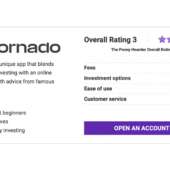Best for Hands-On Investors
The Penny Hoarder rating
$5 to start
Best for New, Hands-Off Investors
The Penny Hoarder’s rating
$5 to start
by Rachel Christian, CEPF®
Senior Writer
Acorns and Stash are popular investment apps aimed at beginners.
They both offer easy, automated ways to invest small amounts of money into a taxable brokerage account. They also give users access to other financial services, like a bank account and individual retirement accounts (IRAs).
But these micro-investing rivals differ in a few key ways. Specifically, investing with Acorns is completely automated while Stash can offer a more DIY, hands-on experience.
In this Stash vs. Acorns review, we’ll give you all the details you need to make the right choice.
Stash and Acorns both make investing accessible to everyday users — even if you don’t have any experience or much money to invest.
However, these apps differ in a few key ways.
Stash vs. Acorns: How Do They Compare?
Stash is also a micro-investing app with a user-friendly interface and $0 account minimums.
But unlike Acorns, Stash gives you the option to handpick your own stocks and exchange traded funds.
Stash can create a diversified portfolio for you based on your financial goals and risk tolerance, the way Acorns does.
Or, you can take a more DIY approach and buy fractional shares of more than 3,000 individual stocks and ETFs.
Prior to March 2021, Stash only allowed users to buy their own investments and manage them on their own. That changed after the company launched Smart Portfolio, its robo-advisor option, which chooses investments based on your profile and rebalances them periodically in response to market changes.
You can make automatic contributions to your Stash personal investment account via spare change rounds-up and Set Schedule, a recurring transfer feature.
Stash offers other financial products with its $3 and $9 per month accounts, including access to IRAs and UTMA/UGMA accounts for children.
Stash has a unique feature called Stock-Back® rewards, which lets you earn stock rewards when you shop with your Stash Visa debit card.
Like Acorns, Stash charges a flat monthly fee for its services.
Stash offers an easy way to invest but it’s important to weigh all the features.
Acorns became one of the first automated investment apps to hit the market back in 2014.
There’s no minimum amount to open an account and you need just $5 to start investing.
Acorns helps you automate investing and save money in a few different ways, including its hallmark round-up feature.
Round-ups put your spare change into the stock market when you make purchases with a linked card. Acorns will round your purchases to the nearest dollar, then sweep the change into your investment account once it hits $5 or more.
You can also automate investing by setting up recurring transfers from your bank account to your Acorns app on a daily, weekly or monthly basis.
These features help set your finances to autopilot. We love that convenience.
However, you can’t pick your own stocks, bonds or ETFs with an Acorns account. (Nope, you can’t buy shares of Tesla or GameStop.)
Instead, Acorns creates a diversified investment portfolio for you.
This lack of customization might be an advantage or disadvantage, depending on how comfortable you are making your own investment choices.
If you’re looking for a truly simplified set-it-and-forget-it approach, it’s hard to go wrong with Acorns.
The app also offers banking products including a debit account, educational resources, custodial accounts for kids and automated retirement account options.
Acorns comes with a unique feature called Acorns Earn, which gives you investment bonuses and rewards when you shop with participating merchants.
Acorns charges a flat monthly fee for its services.
Acorns and Stash share more similarities than differences. They both simplify investing, and they both charge flat monthly fees for their services.
Here are other features both apps share:
Here are the features you’ll only find on Acorns.
Here’s how Stash differs from Acorns.
Both Acorns and Stash take a long view approach to investing. They want you to keep your money in the market long-term, and therefore discourage or even bar you from day trading.
Acorns and Stash both use fractional share purchases, which allows you to buy pieces of an asset even if you don’t have enough money to purchase an entire share.
Remember, investing involves risk. Even though you’re only investing small amounts of money in these apps, there’s always a chance you could lose money in the stock market.
When you sign up for Acorns, you’ll complete a brief questionnaire to determine your age, income, risk tolerance and goals.
From there, Acorns uses computer software and algorithms to select a pre-made portfolio for you.
Portfolio options include:
These portfolios are comprised of exchange traded funds (ETFs), which bundle numerous stocks or bonds into a single fund. Aggressive portfolios are mostly stock ETFs while conservative portfolios are mostly bond ETFs.
You can choose a different portfolio if you disagree with the Acorns algorithm, but you can’t pick your own individual stocks and ETFs.
For environmentally-conscious investors, Acorns offers an ESG (environmental, social and governance) portfolio, which allows you to invest in businesses that prioritize sustainability.
The Acorns app also offers a tax-advantaged retirement account and UTMA/UGMA accounts for minors.
Stash lets you decide how hands-on you want to be with your portfolio.
All Stash users can pick and choose from more than 3,000 stocks, bonds and ETFs.
Like Acorns, Stash will prompt you to complete a brief questionnaire to assess your age, income, risk tolerance and goals.
From there, the app gives you a list of investment options to choose from, including Curated Collections, which bundle assets from similar industries like health care and technology.
Smart Portfolio, Stash’s robo-advisor option, is available with Stash Growth and Stash+.
Similar to Acorns, Smart Portfolios take the guesswork out of investing by putting your money into a predetermined diversified portfolio.
Automated portfolios are made up of a handful of ETFs that give you exposure to the biggest companies around the globe.
Smart Portfolios will also reinvest your dividends and periodically rebalance your portfolio if it drifts 5% away from its target asset allocation.
Like Acorns, you can open a taxable brokerage account, IRA and UTMA/UGMA accounts on Stash.
Both Stash and Acorns offer subscriptions with flat monthly fees.
Stash Beginner is the most affordable option at just $1 a month. (Acorns used to offer a $1 option, called Acorns Lite, but phased this plan out in September 2021.)
If you’re looking for the cheapest investment account (and don’t need an automated portfolio), Stash beats Acorns.
Stash also offers access to a debit account for $1 a month, making it more economical than Acorns if these features are important to you.
However, Stash and Acorns both charge the same amount ($3 per month) to access a fully automated portfolio and retirement accounts.
Acorns is a better deal if you want to open a custodial account for a child.
Acorns Family lets you create multiple custodial UTMA/UGMA accounts for $5 a month. At $9 per month, Stash+ costs nearly twice as much and only lets you access two of these accounts.
Investment apps have to make money somehow, but the flat monthly management fees Stash and Acorns charge can eat into your returns, especially if you have a low account balance.
Many other robo-advisors charge a management fee as a percentage of your portfolio balance. For example, Betterment and Wealthfront charge a 0.25% annual fee, which is much more affordable for small accounts.
If you had $1,000 in a Betterment personal investment account, you’d pay just $2.50 a year in fees. Compare that to at least $12 a year with Stash and at least $36 a year with Acorns.
Stash and Acorns both help you take baby steps toward your financial goals.
Acorns takes a fully automated approach that doesn’t let users select their own stocks and ETFs, while Stash gives you the option to create your own investment portfolio or let a computer do it for you.
Acorns is a better fit if you prefer a simplified, set-it-and-forget experience. It’s also a good choice if you’re looking for a SEP IRA or multiple custodial accounts for children.
Stash works better if you want control over the investments in your personal portfolio, or you’re looking to invest in specific stocks.
Stash also offers a less expensive debit card and banking options.
The “best” option for you really depends on what you want out of an investment app.
Either way, Acorns and Stash both provide safe and simple platforms ideal for new investors who want to get their money in the stock market.
The most important part of investing is getting started, so it’s hard to go wrong with either app.
Rachel Christian is a Certified Educator in Personal Finance and a senior writer for The Penny Hoarder.
The Penny Hoarder is a paid Affiliate/ partner of Stash. Investment advisory services offered by Stash Investments LLC, an SEC-registered investment adviser.
*Offer is subject to Promotion Terms and Conditions To be eligible to participate in this Promotion and receive the bonus, you must successfully open an individual brokerage account in good standing, link a funding account to your Invest account AND deposit $5.00 into your Invest account.
Bank Account Services provided by Green Dot Bank, Member FDIC. Account opening of the bank account is subject to Green Dot Bank approval. Investment products and services provided by Stash Investments LLC, not Green Dot Bank, and are Not FDIC Insured, Not Bank Guaranteed, and May Lose Value.
Stock-Back® rewards is not sponsored or endorsed by Green Dot Bank, Green Dot Corporation, Visa U.S.A. or any of their respective affiliates, and none of the forgoing has any responsibility to fulfill any stock rewards earned through this program.
For additional disclosures, click here.
Ready to stop worrying about money?
Get the Penny Hoarder Daily
Privacy Policy
© 2021 The Penny Hoarder. – All rights reserved.
Privacy Policy and Terms of Service | Do Not Sell My Personal Information | Cookies Settings






